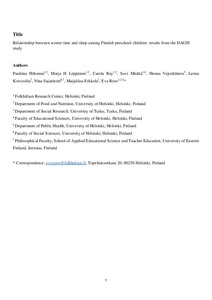Relationship between screen time and sleep among Finnish preschool children: results from the DAGIS study
Hiltunen Pauliina; Leppänen Marja H; Ray Carola; Määttä Suvi; Vepsäläinen Henna; Koivusilta Leena; Sajaniemi Nina; Erkkola Maijaliisa; Roos Eva
https://urn.fi/URN:NBN:fi-fe2021042823659
Tiivistelmä
Study objectives
To
examine the associations between screen time, the time spent on
different screen devices, and sleep in a sample of Finnish preschool
children.
Methods
The
current study analyzed cross-sectional data from the DAGIS study
carried out in Finland in 2015–2016 on 736 children aged 3–6 years.
Parents reported in a 7-day diary the durations the child used screen
devices daily, with separate details about watching TV or DVDs, using
tablets or smartphones, and using computers. In addition, parents
reported children's bedtimes and wake-up times, which were further used
in calculating sleep duration. Parents answered questions regarding
their child's sleep consistency. Statistical analyses included adjusted
general linear modeling.
Results
An
hourly increase in total screen time was associated with 11 min later
bedtime (p < 0.001) and 10 min shorter sleep duration (p < 0.001).
More TV/DVD watching was associated with later bedtimes (p = 0.016) and
a shorter sleep duration (p = 0.001). More smartphone/tablet use was
associated with later bedtimes (p = 0.005), later wake-up times
(p = 0.038), and weaker sleep consistency (p = 0.024). More computer use
was associated with later bedtimes (p = 0.046). Results did not differ
between genders.
Conclusions
Increased
screen time was associated with later bedtimes and shorter sleep
duration among preschool children. Adverse associations with sleep
outcomes were found for each screen device. Attention should be paid to
promoting balanced use of screens and regular sleep habits in young
children.
Kokoelmat
- Rinnakkaistallenteet [27094]
